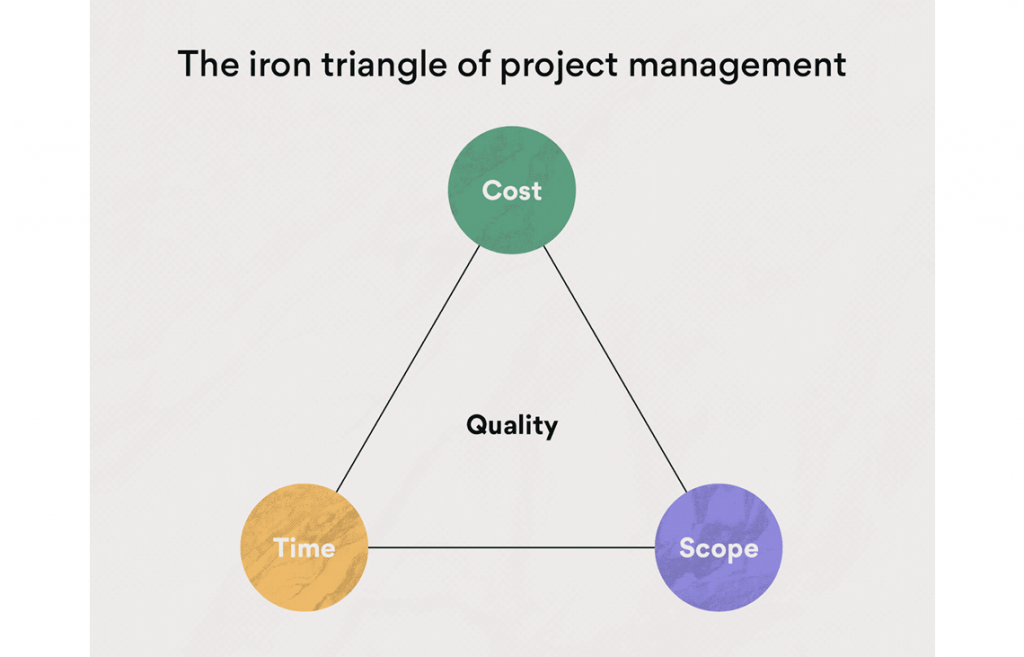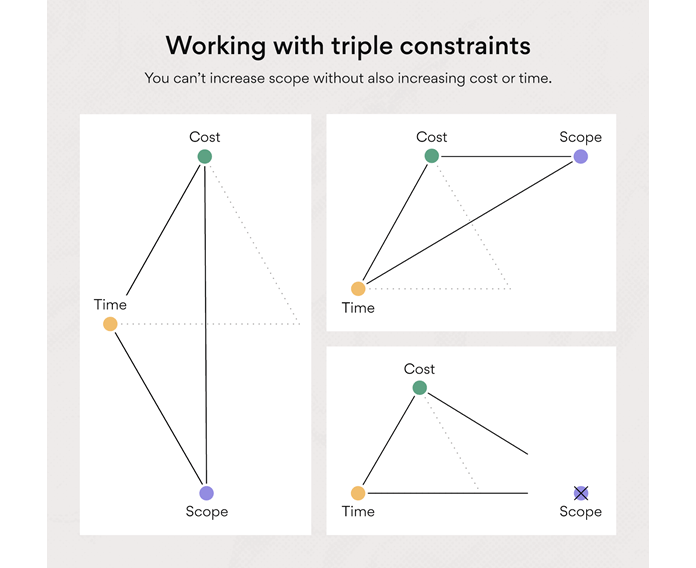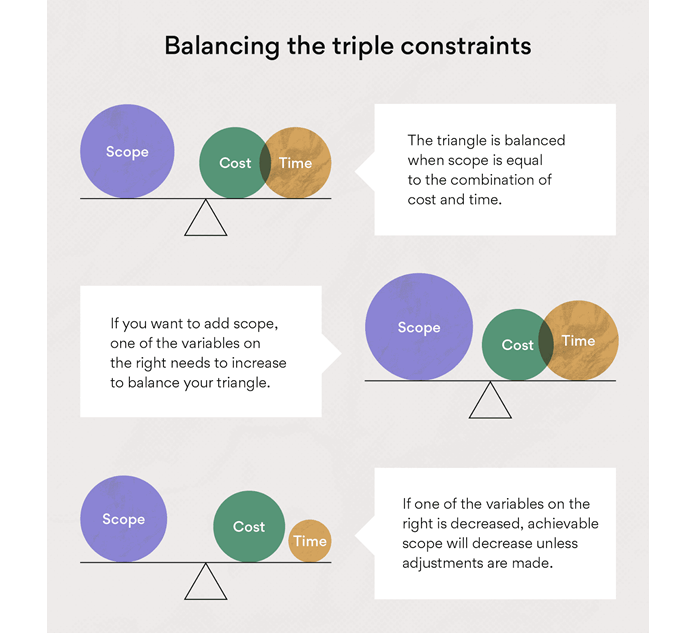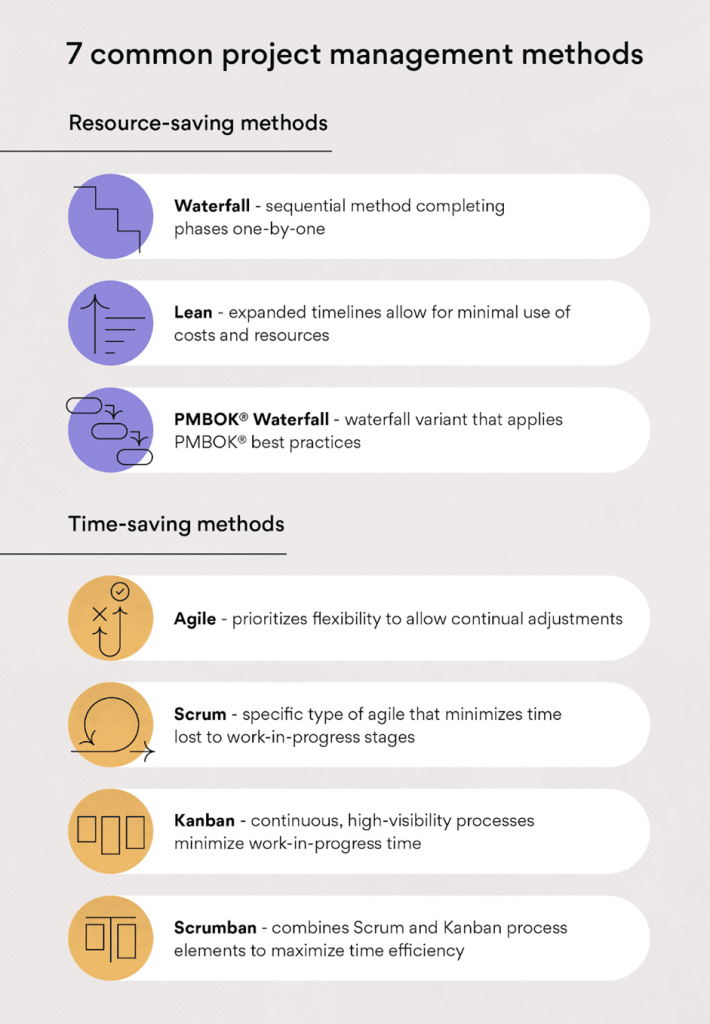Managers take advantage of the project management triangle to evaluate or understand the challenges that may occur throughout the implementation and execution of a project. There will be numerous constraints on all projects, regardless of their size.
Despite some project restrictions, they should not be utilized as obstacles to effective project execution and decision-making.
Let’s take a look at each of the project triangle’s elements and how to deal with the problems that come with them.
What is project management triangle?
The scope, cost, and time factors make up the project management triangle, which determines the project’s quality.
So what is the project triangle? The iron triangle PMP shows how these three variables are related; if one of them is changed, the other two must be modified to maintain the triangle connected. The quality of the project will suffer if the triangle breaks – that means if one point is altered without impacting one or both of the other points.

A project manager’s role is to create a balance between the triangle’s three points in order to achieve the best possible quality while staying within budget, on schedule, and sticking to project standards.
Read more about Project Management
How scope, cost, and time are related
In the project management golden triangle, there are two types of relationships at work. The link between scope and the two other project variables is the first. Scope is proportional to both time and cost, implying that it moves in the same direction as those two variables. In order to take on a greater job, time and money must be increased as well.

The link between time and cost, which is inversely proportional, is the second type of relationship. These two variables are in opposition to one another. If costs must be lowered, deadlines must be extended; but, if you are suddenly faced with a time constraint, you will want additional funds to react to shorter timeframes.
These two relationships can’t be changed—nothing you do will allow you to change one variable without causing a corresponding change in the other two points on the triangle, either directly or inversely. The project triangle is sometimes referred to as the “iron triangle with three constraints” because of this. The iron triangle project management will not bend to a project manager’s will, no matter how strong they are.
The three constraints of the golden triangle (Scope, Cost, Time)
What are the three elements of the project triangle? To keep all three elements in control, the project manager must have a thorough understanding of each variable and where they have the flexibility to adapt changes during the project.

Scope
The scope of a project relates to the “scale” of its deliverables in terms of quality, detail, and magnitude. As the project’s scope expands, more time and resources will be required to complete it.
The scope of the project evaluates the outcome. This consists of a list of deliverables that the project team must complete.
A successful project manager will be able to manage the project’s scope as well as any changes in scope that have an influence on time and cost.
The following are examples of project scope elements:
- Complexity of the project
- Finished product quantity (s)
- Quality of the output
- Strength (e.g., the number of simultaneous users an app can support)
- Level of detail
- Number and complexity of features
Avoid “scope creep” by completing project planning and getting all project stakeholders to sign off on everything before beginning production.
Read more about Project Scope Management
Cost
When starting a project, it’s critical for both the project manager and the organization to have an expected cost. Budgets will ensure that a project is created or implemented at a cost that is within a certain range.
Project managers may be pushed to deploy more resources in order to fulfill deadlines, incurring increased project expenses as a result.
Cost isn’t restricted to cash numbers when it comes to the project management triangle. This triangle point, also known as “resources,” contains all of the tools, equipment, and support needed to execute the project.
The following are examples of scope elements:
- Financial budget
- The total number of team members
- Infrastructure and equipment
- Key opportunities.
Although the cost/resources variable encompasses more than simply money, almost everything inside this point may be linked to a financial value. Adding staff, for example, needs more budget for pay; taking advantage of the opportunity to keep workplaces open longer necessitates a higher budget for electricity use hours.
Time
The activities of a project might take a shorter or longer period to accomplish. The amount of people working on the project, their experience, and skills, among other things, all influence job completion.
Time is an important but uncontrolled aspect. Failure to fulfill project deadlines, on the other side, might have negative consequences. The most common cause for companies’ failure to succeed over time is a lack of resources.
Keep in mind that the amount of time you’re measuring is just as essential as the type of time you’re measuring when adjusting for time. Extended deadlines, changes to team calendar software, the elimination of planning phases, and other tradeoffs may be required.
The following are examples of time elements:
- Timeline for the entire project
- Working hours on the project
- Goalposts and internal calendars
- Planning and strategy time is given
- Phases of the project.
If your budget is decreased or your scope is expanded, you’ll need to discover innovative ways to compensate by relaxing one or more of your project’s deadlines, whether by extending deadlines, increasing hours, or making other scheduling changes.
Quality
Although quality is not a component of the project management triangle, it is the ultimate goal of all deliveries. As a consequence, quality is represented by the project management triangle.
Many project managers believe that “great quality comes at a high expense,” which is accurate to some extent. Using low-quality resources to meet project deadlines does not make sure the project’s eventual success.
Quality will be a key deliverable for the project, much like scope.
The wildcard factor: innovation
When someone discovers a new way of doing something that improves cost-efficiency or speed, they may make this modification without affecting the other aspects of the project management triangle.
Someone in your team, for example, discovers a method to improve the functionality of a project-critical tool. This modification to your production process may allow you to do more in a shorter project schedule or with a smaller team..
Similarly, any changes to the production process that assist standardize processes and reduce decision-making time will allow your team to work more effectively while maintaining high quality. Investing in management tools such as standardized sales templates or project management software will save time and money without affecting project quality or scope.
Strategies for managing the project triangle
Now that you’ve learned what the project triangle is, consider how you might use it in your regular job. It’s also a good idea to look at the five project management phases to see if there are any overlaps.
Prioritize your goals
The project triangle’s central concept is that no project can be successful if there are three rigidly fixed points. At least one point should be flexible, so you know where you have room to make changes if they are required.
If keeping on budget is a top concern, an unexpected obstacle might be addressed by delaying your deadline rather than hiring more employees to rapidly resolve the issue. If your client’s deadline is strict, it’s a good idea to obtain extra funding approved ahead of time so you may solve issues without delaying production.
Set specific expectations and objectives
To avoid unfulfilled expectations and disgruntled owners, properly explain your project’s boundaries and goals to your customer and other stakeholders involved in the project.
Contracts will include unique components that help the project manager get all stakeholders on the same page before the project begins in industries that are prone to unforeseen difficulties, such as construction and engineering. These are some of the elements:
- Clients approve contingency budgets ahead of time.
- A list of common potential stumbling blocks (weather, natural disasters, local events, etc.)
- List of commonly used plans of action for each delay, including cost and time estimates that would need to be added in the event of each contingency
Keep track of the client’s preferences so you can refer to them later if you need to make a project triangle modification, and give stakeholders a clear understanding of the sorts of events that might occur and how they can influence costs and deadlines. There will be no confusion about why those changes were made after the project is completed.
Common project management methods
There are several project management approaches that prioritize various project variables, resulting in a diversity of project triangles. We’ve divided seven popular project management methods into two categories: those that prioritize low costs and those that favor time savings.

Resource-saving project methods
These project management approaches, which prioritize efficient resource usage, will help projects with stricter budgets and greater flexibility in timelines.
- Waterfall: Because project steps are performed in order, timetables must be flexible, as delays in one phase may necessitate changes in all subsequent phases.
- Lean: Lean focuses the minimum possible costs and resources, allowing for extended time frames or scope cutbacks to keep the project within budget.
- PMBOK® waterfall: a variant on the classic sequential waterfall process that uses standards set by The Project Management Institute’s Project Management Body of Knowledge to increase process efficiency.
Time-saving project methods
These project management strategies may eliminate unnecessary downtime and speed project processes to keep teams working quickly in instances where time is of the importance.
- Agile: prioritizes flexible procedures so that teams are ready to respond to change requests with little time or cost increases; organizations that utilize this strategy frequently use agile management software.
- Scrum: a kind of agile project management that is most commonly used in software development. It employs aspects of Scrum methodology such as sprints and daily team touch-bases to reduce time spent in work-in-progress stages.
- Kanban: minimizes work-in-progress time by using continuous, high-visibility collaborative processes; teams that utilize this approach frequently use Kanban software.
- Scrumban: combines the Kanban process’s collaborative and continuous nature with Scrum’s daily team reviews to reduce work-in-progress time.
Of course, the objective of any approach is to achieve the best possible balance of low costs, quick speeds, and excellent quality. Because the project management triangle requires prioritization of at least one variable, these techniques tilt toward the most important variable to the team.
Use all three constraints to your advantage
Though the iron triangle and its system of three constraints may appear to be restrictive at first, if you understand how to use them in your company project management process, you’ll discover that they really help your projects operate more smoothly. You may avoid costly setbacks by having a better knowledge of your limitations and flexibility ahead of time.
Furthermore, the iron triangle will assist you in selecting the appropriate project management software, developing processes, and setting up your production so that your team can get up and running quickly. After that, who knows what you’ll be able to achieve as a team.
A triangle is frequently used to represent project management. To guarantee that the project’s or outcome’s quality is not jeopardized, a skilled project manager must strike a balance between the three constraints.
To address the problems posed by the three constraints, a variety of tools and approaches are available. In order to complete the project effectively, a skilled project manager will utilize the right tools.
Transparency and visibility of the three constraints are critical for properly balancing the Project Management Triangle. You may keep track of how each of the constraints is performing and identify future risks by utilizing project management software.
Visit our websites to get more information and a free PMP Practice Test. To download, visit our website for your IOS or Android device.

What is Project Management Triangle?
In this article, we will provide you with Project Management Triangle, each of the project triangle's elements. Let's get started!
January 1, 2022

Benefits Management and Benefits Realisation Management
If you are wondering about 'benefits management' and 'benefits realisation management'. Visit our website to learn everything!
January 1, 2022

PMP Review with A Successful Story
Let’s read PMP Review which may help you a lot! Visit our website to get more information and free PMP Practice Test!
January 1, 2022
